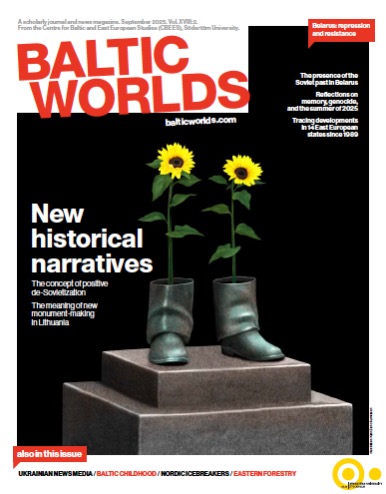Alexandra Biktimirova and Victoria Kravtsova
Alexandra Biktimirova is a student at the HSE University in Moscow and a feminist activist. Research interests center on the intersections of feminism and Islam in the Volga-Ural region in Russia, as well as globally. Coordinated the exhibition Feminist Translocalities in Kazan in 2020. Research interests are gender, muslim women, and relationships between discourses of power and marginality.
Victoria Kravtsova is a Feminist researcher, NGO-worker and activist. Born in Smolensk, Russia. Initiated Feminist Translocalities – a queer feminist network between the former USSR, Germany, and sometimes other locales, as wel l as a platform for supporting projects – publications, exhibitions, seminars, podcasts etc. Research interests include the intersections of feminist, antiracist and decolonial struggles in the countries of the former USSR.
view all contributors
Articles by Alexandra Biktimirova and Victoria Kravtsova
-
Partisan and decolonial ecology is a notion addressed by Andreas Malm and Malcom Ferdinand respectively, in their texts on the Caribbean maroon partisans – the emancipated slaves – who moved to the more mountainous parts of the islands that were still covered by dense vegetation. This concept is here taken to another historical context, that of Yugoslav partisans’ fight against the fascist occupation in the Second World War. I engage in reading an array of partisan artworks that point to fascist domination/war over nature juxtaposed to emerging solidarity among humans and animals/nature. From poems and short stories to drawings and graphic art material, the subject matter of forest as a site of resistance and political subjectivity emerges. Diverse animals, pack of wolves, birds that continue to sing despite the thorny branches, the figure of the snail as the affect and attitude of resilience – these become “comrades” in the struggle, mobilizing nature in their fight against fascism.
-
The study of monuments tends to focus on human agency, in the form of political history, war history, antagonism, trauma and so on. Aesthetic qualities are often seen as superficial and fetishized qualities that belie the impact of the monument in a regional context. The rurally situated monuments of former Yugoslavia, however, must be seen through their extraordinary qualities as works of art, carrying an agency of their own. Rather than restricting the meaning of their impact, their aesthetic qualities and impact in the environment allow them to speak to us today from a new horizon.
-
This special section in Baltic Worlds is the result of a workshop engaging with the politics of aesthetic historicizations, through the grid of the monument.
-
Analyzing Competitive Victimhood: Narratives of Recognition and Non-recognition in the Pursuit of Reconciliation, Çağla Demirel, (Doctoral dissertation: Södertörn University, School of Social Sciences, 2023). 187 pages
-
At home or abroad? Chișinău, Černivci, L’viv and Wrocław: Living with historical changes to borders and national identities. Bo Larsson, (ed.) (Lund: Universus Academic Press, 2020), 560 pages.
-
A sketch for the cover of the second East German edition to Pippi Langstrumpf (1988) showing a girl standing on her head on horseback is the starting point for this article. It was drawn by Cornelia Ellinger, only one year before the fall of the Berlin wall. The sketch becomes a starting point for a discussion of humor and materiality in the reception of Pippi in the GDR.
-
This essay presents the little-known story of the first western package tour to the postwar Soviet Union along with neverbefore-seen photographs from the journey. It also introduces the digitized Oddner archive, which contains an abundance of visual sources on the Soviet Union of 1955.
-
The material landscape of the Baltic states has dramatically changed with the start of the full-scale Russian invasion of Ukraine: the Ukrainian flag, or its distinctive blue-yellow, has saturated the public space. In places once reserved only for the national flag, the Ukrainian flag flies right next to it. Building facades, windows, and walls serve as new surfaces for the display of the yellow and blue. The periodic, holiday-driven appearance of national flags has given way to the constant show of Ukrainian flags.
-
The paper examines Russia’s cultural expansionism that extends beyond the military invasion in Ukraine since 2014. In the first part, I trace Russia’s systematic efforts to seize and manipulate Ukrainian heritage, often under the guise of protection. I also touch on the role of museums in this expansion, where they are used to preserve collections through coercive acquisition and to promote a Russian-centric narrative. The second part of the article delves into the historical relationships between Russia and Ukraine, especially in the context of the Soviet era’s museum infrastructure. Overall, the text calls for new concepts and international efforts to critique Russia’s actions and protect Ukrainian culture.
-
The war crimes committed by the Russian Federation against Ukrainian children include physical harm (murders, injury, mutilation, child abuse, rape), violations of the rule of law (illegal imprisonment; denial of children’s rights to education, security, and access to humanitarian support; abduction; illegal transfer to custody), psychological damage, destruction of educational institutions’ resources, and using children for propaganda and military purposes.
-

 Issue 2025, 2:
Issue 2025, 2: